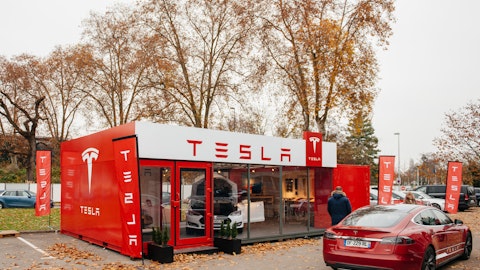Perhaps more interesting is what Larson did not do during the quarter. While Warren Buffett appears to be completely exiting his stake in Wal-Mart, Larson continues to hold the company. Wal-Mart accounted for 4.5% of his portfolio of publicly-traded stocks at the end of the third quarter.
Looking at the rest of the holdings, Crown Castle remains the highest-yielding stock in Bill Gates’ portfolio, followed by Caterpillar and Wal-Mart. Let’s take a closer look at Bill Gates’ dividend stocks:
1: Crown Castle International Corp (NYSE:CCI)
Percent of Bill Gates’ Portfolio: 2.7%
Dividend Yield: 4.6% Forward P/E Ratio: 17.9x (as of 11/18/16)
Sector: REIT Industry: Wireless Communications
Crown Castle International Corp (NYSE:CCI) is a real estate investment trust and the largest provider of shared wireless infrastructure in the U.S.
The company owns about 40,000 towers and 16,500 miles of fiber supporting small cell networks. Crown Castle leases its towers to wireless carriers, which use the company’s infrastructure to provide wireless services to consumers and businesses.
Tenants deploy communications equipment, cables, and antennas on Crown Castle’s towers that transmit signals between the tower and customers’ mobile devices.
Approximately 90% of Crown Castle’s revenue is generated from the big four wireless carriers, and the company is completely focused on the U.S. wireless market.
Crown Castle’s business model has several appealing characteristics. First, its business model has excellent visibility.
Over 80% of the company’s revenue is recurring, and most of its site rental revenue results from long-term leases with initial 10-year terms and five-year renewal periods thereafter.
Crown Castle’s leases also have built-in price escalators, which have historically added around 3% to the company’s annual earnings growth.
Most importantly, there are not viable substitutes for the company’s wireless infrastructure today. Carriers need Crown Castle to operate their businesses, which has helped the company enjoy a non-renewal rate of just 2% over the last five years.
As data demand continues to increase, Crown Castle’s earnings have solid growth potential as the company fills out more of its towers.
Crown Castle began paying dividends in early 2014 and has since raised its quarterly payout from 35 cents per share to 89 cents.
The company targets 6-7% long-term annual growth in dividends per share going forward and should seemingly have little problem hitting this goal.
Crown Castle’s healthy dividend is supported by its reasonable dividend payout ratio and high incremental profit margins (adding more tenants to existing towers requires very little capital).
For investors seeking a high dividend growth REIT, Crown Castle International Corp (NYSE:CCI) is one to keep an eye on.
Read More: Crown Castle Dividend Stock Analysis
Follow Crown Castle Inc. (NYSE:CCI)
Follow Crown Castle Inc. (NYSE:CCI)
2: Caterpillar Inc. (NYSE:CAT)
Percent of Bill Gates’ Portfolio: 5.4%
Dividend Yield: 3.3% Forward P/E Ratio: 27.8x (as of 11/18/16)
Sector: Industrial Products Industry: Construction and Mining Machinery
Caterpillar Inc. (NYSE:CAT) primarily manufactures construction and mining equipment, diesel and gas engines, industrial turbines, and locomotives. Approximately 85% of the company’s operating income comes from its Construction Industries and Energy & Transportation segments.
In addition to heavy equipment sales, Caterpillar generates a significant amount of revenue from higher-margin less volatile aftermarket parts and components. However, the company does not disclose how much revenue is from its aftermarket business.
The company is also very global with more than 60% of its sales generated outside of North America.
Caterpillar’s competitive advantages are derived from its reputation for quality and global scale.
The company’s success starts with its dealers. Caterpillar Inc. (NYSE:CAT) sells its products to dealers who sell them to end users across different markets. Caterpillar’s global network of more than 175 independent dealers is second to none – the company’s largest competitor (Komatsu) is about half of its size.
Having the biggest dealer network assures customers that their equipment will remain up and running. A machine that breaks can stop an entire job and make or break a project’s financial and operational objectives.
Large dealers with plenty of parts and technicians are a key selling point for customers because they can respond more rapidly and cost-effectively to machine breakdowns.
Lower-priced Asian competitors lack a global dealer support network and have struggled to take share from Caterpillar. In fact, Caterpillar has increased its machine market share for five years in a row.
Caterpillar’s dividend has also remained intact for now. The company has paid a dividend every quarter since 1933 and has raised its dividend for more than 20 consecutive years.
Despite the slump in commodity and construction markets, Caterpillar has said the the dividend is “certainly very important to the board and to management. We have very good cash flow right now that more than covers the dividend.”
The company’s free cash flow payout ratio sits near 55%, and the company maintains nearly $6 billion in cash on hand compared to total dividend payments of $1.8 billion last fiscal year.
Management last raised the dividend by 10% in the summer of 2015 but opted to hold the dividend steady during the summer of 2016. Until end markets begin to recover, new dividend increases are unlikely. Investors interested in more information about the safety of Caterpillar’s dividend can read my latest assessment here.
The stock has rallied hard on Donald Trump’s election, which could mean more infrastructure spending and thus greater demand for Caterpillar’s heavy machinery. Trump could also make it more difficult for Komatsu to compete with Caterpillar Inc. (NYSE:CAT) with new trade and tariff agreements. However, a lot remains to be determined.
Follow Caterpillar Inc (NYSE:CAT)
Follow Caterpillar Inc (NYSE:CAT)





